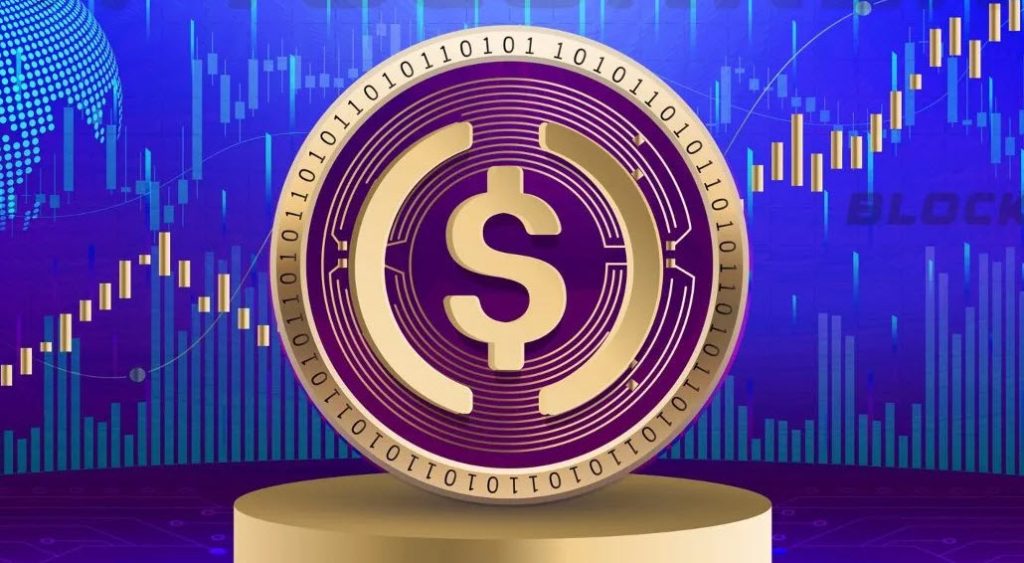USDC
Warning: session_start(): open(/var/cpanel/php/sessions/ea-php83/sess_88dd2e416a4b1ce931f34b8da7588859, O_RDWR) failed: Disk quota exceeded (122) in /home/infoshop/public_html/wp-content/plugins/feeder-setup/misc/geo.php on line 34
Warning: session_start(): Failed to read session data: files (path: /var/cpanel/php/sessions/ea-php83) in /home/infoshop/public_html/wp-content/plugins/feeder-setup/misc/geo.php on line 34
Contents
The USDC is a cryptocurrency managed by the U.S. Based corporation Circle Internet Financial Limited, is a peer-to-peer payments technology company.
The USDC is marketed as a stablecoin and is allegedly backed by sufficient United States Dollar reserves to keep the value of the USDC pegged to the value of the U.S. Dollar. The name USDC is an acronym for U.S. Dollar Coin, but make no mistake – this is a private cryptocurrency and not a physical or digital U.S. Dollar coin issued by the U.S. Federal Reserve.
As with other so-called stablecoins, concerns have been raised in regards to the issuers inability to satisfyingly prove that they are actually always keeping sufficient reserves to back the cryptocurrency.
Stablecoins are digital currencies designed to be pegged to another asset in an effort to reap the benefits of blockchain coins (e.g. blockchain transactions) without having to deal with the big value fluctuations and exchange rate risks typically associated with cryptocurrencies.

Origin and Operations of the USDC



The U.S. Dollar Coin was launched in 2018 by CENTRE, a collaboration between the cryptocurrency company Circle and the popular cryptocurrency exchange Coinbase. USDC is designed to maintain a 1:1 parity with the U.S. Dollar. This means that for every USDC in circulation, there is an equivalent U.S. Dollar held in reserve. This design offers users the combined advantages of blockchain technology, like transparency and security, with the relative stability of the U.S. Dollar.
USDC operates on the Ethereum blockchain, which is among the most widely recognized and utilized blockchains in the world. As an Ethereum ERC-20 token, USDC can be stored in any Ethereum wallet and is accepted across numerous exchanges and platforms. USDC has the capacity to be utilized on other blockchains than Ethereum, and was for intance used within the Tron ecosystem until early 2024.
Short Facts About the USDC
Abbreviation: USDC
Initial release: September 2018
Developer: Circle Internet Financial Limited
White paper: https://f.hubspotusercontent30.net/hubfs/9304636/PDF/centre-whitepaper.pdf
Website: Circle.com/en/usdc
Examples of notable USDC milestones
May 15, 2018: Circle announces the USDC
September 2018: USDC is launched by the Centre consortium, a joint venture between Circle and Coinbase
March 2021: Visa announced their intentions to permit the use of USDC to settle transactions on the Visa payment network.
July 2022: Circle announced that there was 55 billion USDC in circulation.
March 2023: Starting on March 11, the USDC lost its peg to the dollar for several days. This came after an announcement from Circle, saying that 3.3 billion USD (approximately 8% of its reserves) were at risk because of the collapse of the Silicon Valley Bank. After four days, the USDC regained its peg to the USD.
August 2023: Circle and Coinbase closed the Centre consortium, and handed over the complete governance of the USDC to Circle.
2023: Visa launched a pilot program to send USDC over the Solana blockchain to the payment firms Nuvei and Worldpay, who would then transfer money to merchants.
February 2024: After a risk management assessment, Circle discontinued USDC on the Tron blockchain, and users were given until February 2025 to move their USDC from Tron to other blockchains.
Potential Benefits of the USDC
One of the most significant benefits of the U.S. Dollar Coin is its relative stability in relation to the U.S. Dollar. While other cryptocurrencies can fluctuate wildly in value, the USDC’s price usually remains stable and follows the value of the U.S dollar. Just like other stablecoin, the USDC is seen by many crypto-investors as a safe haven during volatile market conditions.
Being a stablecoin, the USDC is appealing to users who want the benefits of blockchain transactions without the volatility of cryptocurrencies such as Bitcoin and Ether. USDC transactions are completed on a blockchain, ensuring they are swift. Traditional banking systems can often take days for fiat money transactions to clear, but a USDC transaction can be completed in a matter of minutes, regardless of the location of the sender and receiver.
Using USDC does not require a traditional bank account, providing financial services to those people who are unbanked or underbanked. This cryptocurrency can be sent or received from anywhere in the world, allowing for global financial inclusivity.
The USDC leverages the transparency inherent to blockchain technology. Every USDC transaction is recorded on the Ethereum blockchain, providing a level of transparency that can help combat fraud and other financial crimes. Of course, as with other blockchain currencies, this has also raised privacy concerns, and some crypto-users prefer to stick with cryptocurrency networks that put more emphasis on privacy, are not run by a corporation, and are less inclined to work with law enforcement.
The Reserves
USDC´s peg to the U.S. Dollar hinges on Circle having enough reserves to back their claims. When market faith in these reserves goes down, the market price of the USDC begins to move.
USDC reserves are regularly attested, but not audited, by Grant Thornton LLP. This is one of the top-10 largest accounting and advisory organizations in the United States by fee income, and it is a part of the huge accounting network Grant Thronton International.
Until mid-2021, Circle claimed that each USDC was either backed by 1 dollar held in reserve or by “other approved investments”. Details regarding these “other investments” were not released. In June 2021, Circle changed the wording on their website from “backed by US dollars” to “backed by fully reserved assets”.
In March 2023, the Silicon Valley Bank collapsed, and Circle announced that 3.3 billion USD (roughly 8% of the total reserves) were at risk because of this. The market reacted, and the USDC lost its peg to the USD for a few days, starting on March 11.
This article was last updated on: May 19, 2024